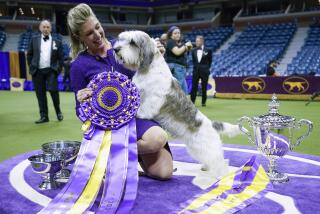This Dog Fancier Crowns Tramps as Best-Bred Champs
- Share via
As hordes of the coiffed and blue-blooded take their leave of Manhattan’s Madison Square Garden and the just-concluded 124th Westminster Kennel Club Dog Show, I am compelled to praise the mutt--the mixed-breed, Heinz 57 variety dog, the mongrel for whom Louis Vuitton has not designed a carrying case, the hound whose picture cannot be found on a refrigerator magnet, in a “How to Care for Your. . . .” book or on an American Kennel Club registration certificate.
I wish to make my position clear. Am I claiming that a mutt--a result of undirected and frequently unknowable parentage, an animal often elevated from the streets or plucked from the death row of an animal shelter--is just as good as a purebred dog, whose lineage has been shepherded through generations of superior specimens? I am not.
I am claiming that a mutt is better.
I admit to a certain sick fascination with the Westminster Dog Show, with its eccentric, dog-mad participants and with the absurdity of placing vastly different dogs in competition with one another by judging which comes closest to its own breed standard.
*
Most of all, I am struck by an irony central to the lot of a purebred dog: As it attains the hallmarks of its breed, it seems to simultaneously relinquish its basic dogginess, until it is less a dog than a Pomeranian, collie or bloodhound. Let’s face it: A Yorkie is only a Yorkie--whether it’s a dog at all is questionable.
But a mutt is a dog. He is a creature allied to species, not breed, untrammeled by human hand or preference. Unlike a purebred, bred to attain the standard of some anonymous person’s aesthetic opinion, each mutt is paradoxically unique, the product of a now broken mold.
And purebred dogs, unlike mutts, can be rather frail. Like those European royal families of the 19th century, the animals are so aggressively inbred that many breeds have, by now, their own earmarked diseases or infirmities. Bulldogs, their faces bred flatter and flatter over the years, are known for breathing problems. Dachshunds, bred long, suffer spinal problems. Huskies go blind more often than other dogs. And Labs and other retrievers--to put it delicately--are stupid. It isn’t their fault, poor things. They’ve been mercilessly messed with, altered in color, feature and trait, their DNA cut and pasted over countless generations.
And for what?
AKC breed specifications are sometimes related to the work a breed traditionally did in the misty past--a Jack Russell terrier, for example, should have a strong tail because he might get stuck chasing a rabbit into a hole and need to be pulled out, but--remind me--what important work did a Maltese perform?
And while we’re at it, what possible difference does it make whether a Great Dane’s ears point straight up?
Watching the dog-show judges finger the dogs’ tails, peer at their teeth and feel their bones, I am always reminded of a scene in “Europa Europa” in which the eugenics professor measures a schoolboy’s head and pronounces him satisfactorily Aryan. (He’s actually Jewish.)
*
Yes, I acknowledge the reverse snobbery of mutt devotion: My mutt is indeed better than your AKC registered dog--hale where yours is delicate, intelligent where yours is dim, game where yours is standoffish. My dog is vicious to the uninvited guest, affectionate to the invited one and so freakishly acute that he has mastered the English language.
When people frown at him and ask, “What breed of dog is that?,” I can only say that he transcends breed. And to those who competed for best in show at the Westminster Kennel Club Dog Show? I humbly submit that the best dogs of all weren’t even in the running.
More to Read
Sign up for Essential California
The most important California stories and recommendations in your inbox every morning.
You may occasionally receive promotional content from the Los Angeles Times.










